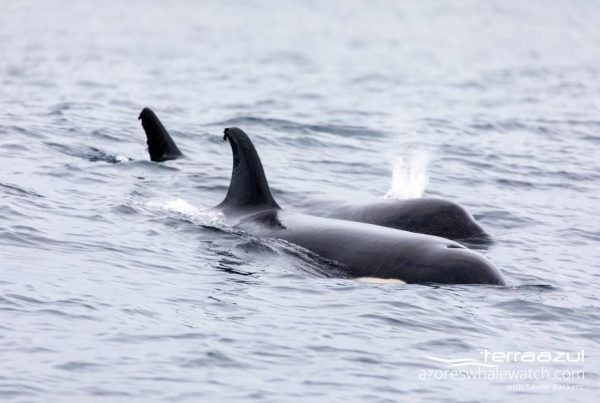
After almost a month of good sea state conditions due to low northern winds, today we were able to go out at sea only in the morning. An eastern wind component was starting to break the sea surface during our first tour, and later as the wind picked up we were forced to cancel the afternoon tours.
We were though able to enjoy the morning in the company of three dolphins species: the Atlantic spotted dolphins, which were busy foraging together with the Cory’s shearwaters, a solitary bottlenose dolphin travelling towards East, and a nice group of adult common dolphins, which were at first socializing and later started foraging.

Atlantic spotted dolphins with Cory’s shearwaters / Stenella frontalis with Calonectris diomedea borealis
While socializing the common dolphins were mostly tight, with some in body contact. Aerial activity such as headslaps and breaches could be also observed. Later when they started foraging the group became more loose and the shearwaters which were resting at the surface started to follow them.

Breaching common dolphin / Delphinus delphis

Cory’s shearwater taking off / Calonectris diomedea borealis
The bottlenose dolphin was likely only temporarily alone. It is not the first time we see solitary individuals, although on average we found bottlenose dolphins in groups of about 5-10 individuals. The social structure of bottlenose dolphins is called fission-fusion not just for coincidence as they are very dynamic and may join and split on a regular basis.
However, exist worldwide cases where individual solitary dolphin do not have social interaction with conspecifics and eventually reorient social behaviour towards humans. These are the so called solitary sociable dolphins. Examples of famous solitary sociable dolphins are Pelorus Jack, a male Risso’s dolphin that used to follow ferries in New Zealand between 1888 and 1912, and Fungie and Jojo, two bottlenose dolphins interacting with humans since the 80s in Ireland and in the Bahamas respectively.
There are a number of problems arising between solitary dolphins and humans when the behaviour of the latter is inappropriate. This may be due to the tendency of seeing dolphins in an anthropomorphic way or due to a fundamental lack of information on the natural needs of wild and free-living. Accidents may derive from such interactions, as it occurred with Filippo, a bottlenose dolphin in the Gulf of Manfredonia, Italy, which after almost a decade of regular contact with local humans, in 2004 was found dead for a fatal boat propeller injury.

Respecting dolphins and don’t forgetting their wild nature and needs is the best way to fully enjoy them 😉



















Your thoughts on this?